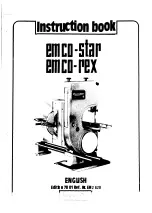
- 6 -
RIP-SAWING WITH
TABLE CANTED:
The circular-saw table
(Sketch 7 and Photo
KS 6) can be canted
up to 45
°
. This enables
bevel cuts to be made
even on long compo
nents. To cant the
table, loosen the two
M 6. 00-33 nuts; the
tab I e can then be
canted to the desired
angle as indicated by
the protractor on the
segment.
M 6.22
M 6. 00-33
Before each cut make sure that the two
M
6. 00-33 nuts
are firmly tightened up (table might tilt).
Sketch 7
right -hand groove
Sketch 8
::======::::: ::=======:::::
CROSS-CUTTING LONG ITEMS:
The medium-pitch saw blade should be used for cross
cutting. The support M
60.
l l is fitted in its holder
(Photo KS 7) and set to the same height as the saw table.
The support M
60. 11
can then be pushed to the end of the
guide bars M
6.27-02
(i.e. hard over to the right) and
secured in place by tightening up the wing nut M
60. 12-2.
The saw arm M
6.22
should be removed by unscrewing
the two nuts
M 6.00-33,
for cross-cutting long compo
nents.
CROSS-CUTT I NG SHORT ITEMS:
It is possible to cut off pieces at the required angle only
if the mitre fence is used. The component should be held
hard up against the mitre fence (Sketch 8).
For cutting off long pieces of wood or to support the wood
more firmly is may be desirable to fit the mitre fence in
the right-hand groove.
In this case, the saw arm must first be removed.
If a large number of pieces are to be cut off it is, advisable
to fit a deflector wedge to the table. This then deflects
the offcuts away from the saw blade and prevents them
being thrown back (see Sketch 8).










































